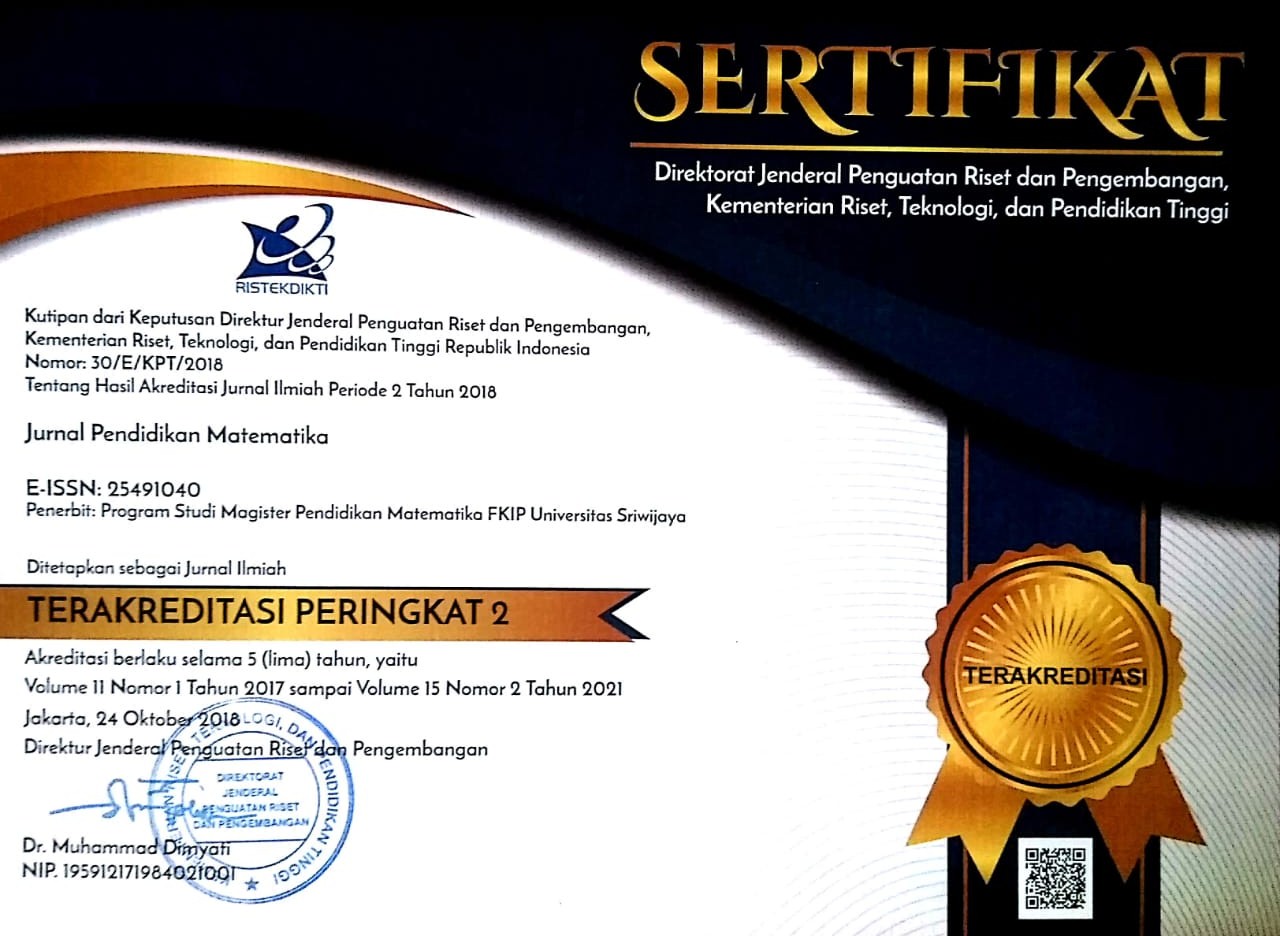Development of Learning Media with Mathematical Understanding in Geometric Sequences and Series within Malay Islamic Context
Abstract
This research aims to develop mathematical learning materials for understanding geometric sequences and series within the context of Malay Islamic culture, which can provide a valid and practical connection to mathematics and enhance mathematical comprehension skills. The research follows the Tessmer 1993 research procedure, encompassing two stages: introduction and prototyping, with a formative evaluation process. The research findings indicate that the learning materials are suitable for implementation, as demonstrated by assessments. The validity of the materials, as assessed by experts, is 93%, signifying their high suitability. The practicality of the learning materials, based on student feedback, is 79%, indicating their practical utility. As for their potential to enhance mathematical abilities, the results show an 82% positive impact on mathematical understanding abilities, as determined from student practice. Furthermore, the mathematical understanding ability of students using these learning materials was rated at 75%, indicating a high level of comprehension of geometric sequence and series content. Consequently, the developed learning materials are suitable for use in the educational process.
Keywords
Full Text:
PDFReferences
Akker, J. an van den, Branch, R. M., Gustafson, K., Nieveen, N., & Plomp, T. (1999). Design Approaches and Tools in Education and Training (1st ed.). Springer, Dordrecht. https://doi.org/10.1007/978-94-011-4255-7
Bakri, S. (2020). Malay Islam: Mosaic of Islamic Culture in Singapore & Brunei [in Bahasa]. Surakarta: PT Aksara Solopos.
Brooks, S. (2016). Tradigital Animate CC :12 Principles of Animation in Adobe Animate. Florida: CRC Press. https://doi.org/10.1201/9781315795614
Hendriana, H., Rohaeti, E. E., & Sumarmo, U. (2017). Students' hard skills and soft skills in mathematics [in Bahasa]. Bandung: Refika Aditama.
Hikmah, R. (2017). Application of the Advance Organizer Model to Improve Students' Comprehension Ability [in Bahasa]. SAP, 1(3), 271–280. http://dx.doi.org/10.30998/sap.v1i3.1204
Khairani, B. P., Maimunah, & Roza, Y. (2021). Analysis of the Mathematical Concept Understanding Ability of Class XI SMA/MA Students on Sequences and Series Material [in Bahasa]. Jurnal Cendekia: Jurnal Pendidikan Matematika, 05(02), 1578–1587. https://doi.org/10.31004/cendekia.v5i2.623
Kompri. (2017). Study the Factors that Influence It [in Bahasa]. Yogyakarta: Media Akademi.
Mahdini. (2003). Islam and Malay Culture [in Bahasa]. Pekanbaru: Daulat Riau.
Meredith D. Gall, Joyce P. Gall, W. R. B. (2003). Educational Research An Introduction (7th ed.). Pearson Education, Inc.
NCTM. (2000). Principles and Standards for School Mathematics. The National Council of Teachers of Mathematics.
Prastyo, I. S., & Hartono. (2020). Development of Learning Media Using Adobe Animate CC on Parabolic Motion Material [in Bahasa]. Phenomenon : Jurnal Pendidikan MIPA, 10(1), 25–35. https://doi.org/10.21580/phen.2020.10.1.6854
Saniriati, D. M. D., Dafik, & Murtikusuma, R. P. (2021). Development of Adobe Animate Learning Media Assisted by Schoology on Arithmetic Sequences and Series Material [in Bahasa]. Jurnal Riset Pendidikan Dan Inovasi Pembelajaran Matematika (JRPIPM), 4(2), 132–145. https://doi.org/10.26740/jrpipm.v4n2.p132-145
Sari, V. P. (2019). Development of Mathematics Learning Multimedia Material on Sequences and Series for Students of Muhammadiyah Vocational School 06 Medan T.P 2019/2020 [in Bahasa]. Published Thesis. Medan: Universitas Muhammadiyah Sumatera Utara.
Sugiyono. (2020). Quantitative, Qualitative, and R&D Research Methods [in Bahasa]. Bandung: Alfabeta.
Sundayana, R. (2015). Media and Teaching Aids in Mathematics Learning [in Bahasa]. Bandung: Alfabeta.
Sundayana, R. (2018). Educational Research Statistics [in Bahasa]. Bandung: Alfabeta.
Sutirman. (2013). Media and Innovative Learning Models [in Bahasa]. Yogyakarta: Graha Ilmu.
Tessmer, M. (1993). Planning and Conducting Formative Evaluations: Improving the Quality of Education and Training. London: Kogan Page. https://doi.org/10.4324/9780203061978
Widoyoko, S. E. P. (2009). Learning Program Evaluation [in Bahasa]. Yogyakarta: Pustaka Belajar.
Wijayanto, T. A., & Munandar, D. R. (2021). Error Analysis in Sequences and Series Material Judging from the Ability to Understand Concepts by Providing Learning Video Material [in Bahasa]. Jurnal Pembelajaran Matematika Inovatif, 4(3), 699–708. https://doi.org/10.22460/jpmi.v4i3.699-708
DOI: https://doi.org/10.22342/jpm.17.3.21971.379-396
Jl. Srijaya Negara, Bukit Besar
Palembang - 30139 Indonesia
Jurnal Pendidikan Matematika is licensed under a Creative Commons Attribution-NonCommercial-ShareAlike 4.0 International License.
Indexed in:


